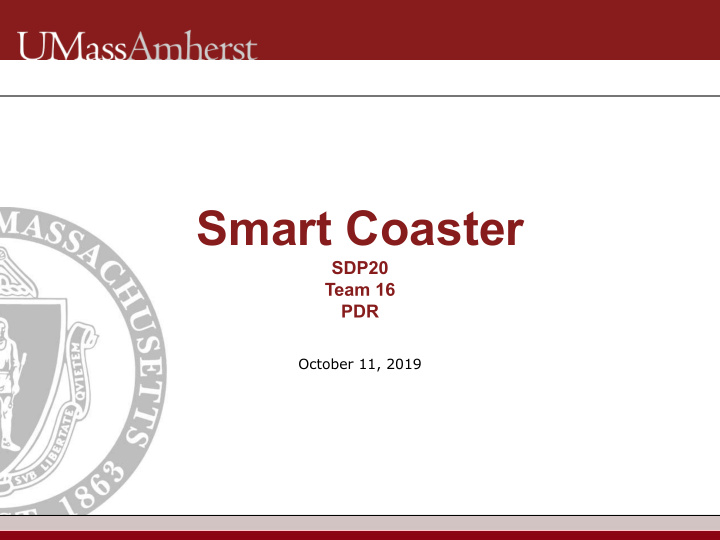



Smart Coaster SDP20 Team 16 PDR October 11, 2019
Meet the Team Professor Joshua Jonathan Capozzi Timothy Shum Angus Mo Joshua Howell Yang EE EE EE CSE Advisor 2
Problem Statement At restaurants, fast and responsive service leads to higher customer satisfaction. Waiters/waitresses often juggle serving several tables at the same time. A customer might finish their drink and have to wait a while for service. 3
Solution - Smart Coaster ▪ Monitor multiple tables’ drinks with ease Coasters connect to a single device to easily see what • table needs a drink/refill ▪ Faster customer service response Coasters send a notification to the smart device when • a cup is emptied ▪ Intuitive system Low maintenance coaster with long lasting battery life • 4
Similar Products ▪ Brio Smart Coaster New Potato Technologies • Interactive app • recommends pubs and restaurants Includes coaster position • tracking “Drink Guard” notifies if • a drink has been tampered with 5
Similar Products ▪ HYDRATE.ME NYU Design Team • Coaster reminds user periodically to drink water • Notifies the user when to refill water bottle • Widget provides visual representation of water bottle • 6
Specifications ● >95% “empty glass” detection rate ● <1% “empty glass” false positives ● >12hr battery life ● <5hr recharge time ● <2cm coaster thickness ● Supports multiple coasters ● Accurately detects a new/refilled beverage ● Accurately determines weight of glass itself ● Accounts for ice or other leftovers ● Reach Goal: Wireless charging station 7
Block Diagram 8
Block Diagram 9
Block Diagram - Sensing Components ● Possible Implementations: ○ Load Cell High precision ■ Bulky - adds thickness ■ High cost ■ ○ Force Sensitive Capacitors Thin/small form factor ■ Low precision ■ High cost ■ ○ Velostat - Variable Resistor Thin/small form factor ■ Low precision ■ Low cost ■ 10
Block Diagram - Sensing Components Force Sensitive Resistors: Compact and discrete form factor ● Capable of measuring weight within desired weight ● range (50 - 300 grams) Figure 1. Plot of resistance vs force for a force sensing resistor. Source: https://learn.adafruit.com/assets/429 11
Block Diagram - Sensing Components Figure 1. Plot of resistance vs force for a force sensing resistor. Source: https://learn.adafruit.com/assets/429 12
Analog Digital Converter ▪ Needs to translate analog voltage into a force/weight measurement (ADC) Figure 3. Expression for evaluating the ADC output value based ▪ Has enough resolution to on the input voltage detect small changes in weight ▪ Low power consumption Figure 4. Translation of ADC input voltage into output codes Figure 2. Wiring diagram of the force resistive sensor into the Microcontroller ADC 13
Wireless Communication Requirements: Nordic Semiconductor's nRF24L01+ is a common ▪ Send status notification 2.4GHz radio transceiver IC for wirelessly to a central hub low power/bandwidth scenarios. ▪ Does not have to be ▪ 1.9V-3.6V real-time, i.e. report status Transmission: ~12mA • every few seconds Standby: 26µA • ▪ Low power communication Power down: 0.9µA • ▪ Working range up to 100m in open space 14
Block Diagram - Software Requirements ● Determine expected empty and full weights Each range is bounded by the empty weight and ○ max full weight Relate weight ranges to container types ○ Standard glass, coffee mug, wine glass, etc. ○ ● Detect empty drinks with ice/other leftovers Log the time when the weight last changed by ○ more than some threshold Track how long a drink has gone untouched ○ ● Notify staff Alert waiters/waitresses when drink is low/empty ○ Hub notifies app to send alerts ○ 15
MDR Deliverables Arduino-driven coaster and hub prototype ● Sensor Accuracy: Weight error <10 grams ○ Differentiate between drink levels ○ ● Coaster Functionality: Full, half-full, empty ○ ● System Communication: Hub receives and logs weight sent from coasters ○ 16
Prototype Cost Analysis Coaster: Hub: ● Enclosure: $15 ● Enclosure: $15 ● Processing unit: $25 ● Processing unit: $25 ○ Microcontroller ○ Microcontroller ○ PCB ○ PCB ○ Passive ○ Passive Components Components ● Wireless comms: $7 ● Wireless comms: $7 ● Battery: $5 ● Force sensors: $25 Coaster Total: $77 HUB Total: $47 17
Major Tasks Josh Angus Wireless implementation Embedded Software ● ● App/UI Development Data analysis/processing ● ● Tim Jon Hardware/Sensor PCB ● ● implementation Power budgeting ● Enclosure Design ● 18
Questions?
References ▪ FSR Wiring https://www.electronicdesign.com/analog/signal-conditioning-force-sensing-resistors • ▪ Connecting FSR to AVR https://learn.adafruit.com/force-sensitive-resistor-fsr/using-an-fsr • ▪ MCU Wifi https://circuitdigest.com/microcontroller-projects/esp8266-nodemcu-with-atmega16-avr-microcontroller-to-s • end-an-email ▪ nRF24L01+ RF Transceiver IC https://lastminuteengineers.com/nrf24l01-arduino-wireless-communication/ • ▪ Force Sensing Resistor (FSR) https://www.adafruit.com/product/1075 • 20
Recommend
More recommend